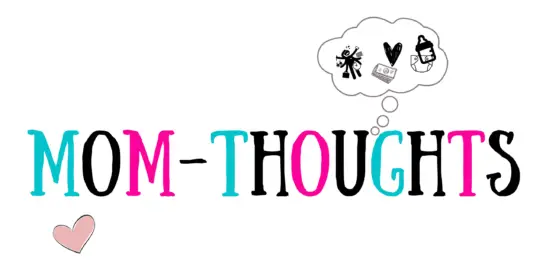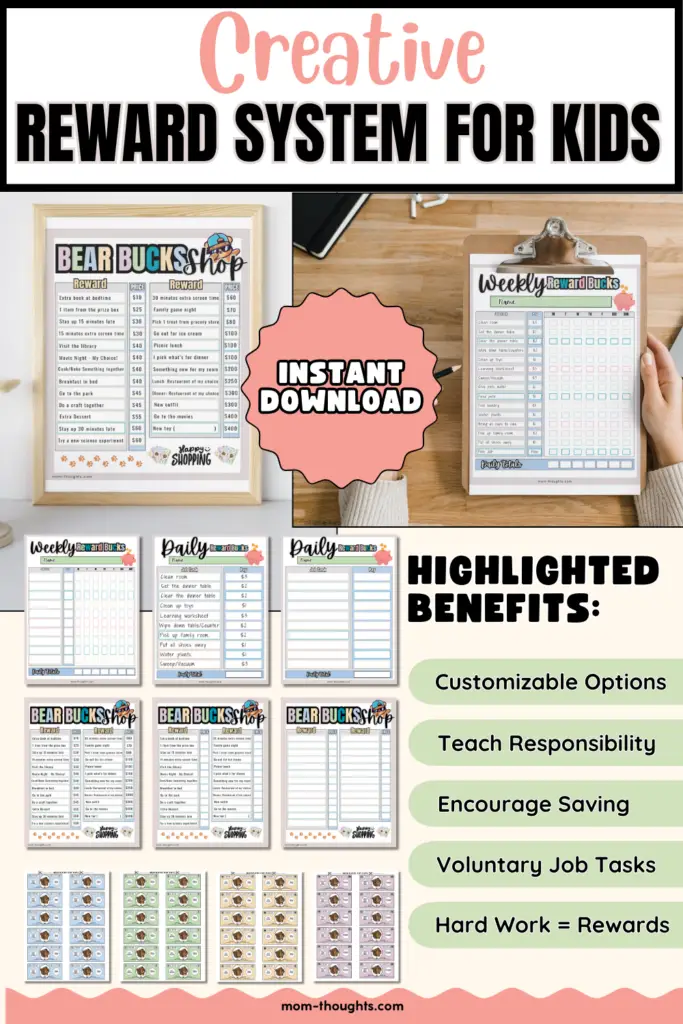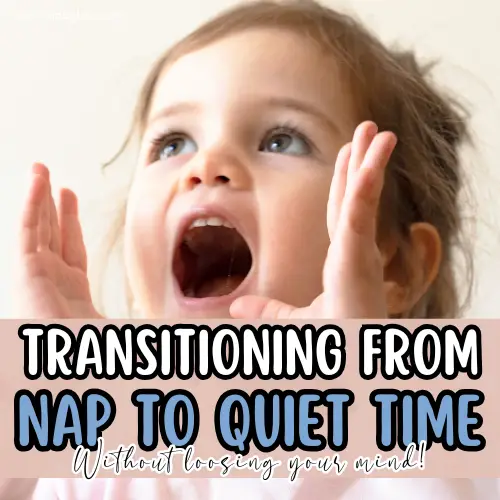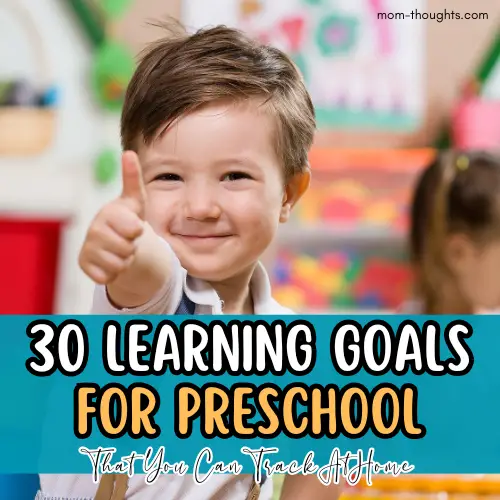This post is all about teaching kids about money.

Teaching Kids About Money – The Fun Ways
Money is often a tricky concept for kids to understand, but it’s one of the most valuable life lessons we can start teaching early. Even preschoolers can begin learning the basics. Like that money is earned through effort, that it can be saved for something special, and that spending always involves making choices. These early lessons help shape their sense of responsibility and independence as they grow. When it comes to teaching kids about money, you don’t need fancy programs or apps to start.
SEE THIS POST ON TIPS FOR USING THE BEAR BUCKS REWARD CHART SYSTEM
With just a few simple tools and some consistency, you can make learning about money both fun and meaningful. One of my favorite ways to do this is through the Bear Bucks Rewards System. It’s a printable system that uses adorable play money designed to represent $1, $5, $10, and $20 bills. Kids earn “Bear Bucks” for chores or positive behaviors, then save and spend them in a reward shop, just like real life! It’s a hands-on way for young kids to practice real-world money skills while also building good habits.
As a means for providing for my family I may earn a small commission if you purchase through the links on this page. Full Disclosure can be found here.
Why Teaching Kids About Money Matters
When kids learn how money works from a young age, they’re developing more than just math skills. In fact, they’re building life skills. They start to understand that effort has value, that saving leads to bigger rewards, and that patience pays off. These lessons carry over into how they approach schoolwork, friendships, and even decision-making as they get older.
Teaching kids about money also sets them up for long-term confidence. When they understand how earning, saving, and spending work, they grow up feeling capable and empowered instead of overwhelmed by finances later on. And the earlier we start these lessons, the easier it is for them to grasp the concepts naturally through play and daily routines rather than lectures or strict rules.
Start with the Basics: Earning Money
One of the best ways to teach kids about money is by showing them that it’s earned, not given. Kids can begin learning this concept as early as preschool, especially when you connect “earning” with helping around the house or showing responsibility. Even simple tasks like cleaning their room, setting the table, or feeding pets can earn them a little “income.”
That’s where the Bear Bucks Rewards Chart comes in handy. Each chore or task is assigned a specific value, like $1 for smaller jobs and $5 or $10 for bigger ones. Kids can clearly see how different amounts of effort lead to different rewards, and they love watching their earnings grow over time. It’s a great introduction to the real-world idea that work leads to money, and money gives you choices.
Parents can even take it a step further by holding a “payday” each week. This gives kids a tangible sense of earning and responsibility. Plus it makes it so much more exciting when it’s time to save or shop in the Bear Bucks reward store!
Saving and Budgeting: Making Smart Choices
Once kids start earning money, it’s the perfect time to teach them about saving. Even little ones can understand the excitement of setting a goal and working toward it. Maybe your child wants to “buy” a trip to the park or a movie night from the reward shop. Helping them save their Bear Bucks for something bigger teaches patience, discipline, and decision-making in a fun, age-appropriate way.
The Bear Bucks Rewards Chart makes this easy by connecting everyday chores to both short-term and long-term rewards. Kids can decide if they want to spend $10 on extra dessert tonight or save $100 for a trip to the ice cream shop. This naturally opens up conversations about budgeting, priorities, and the value of waiting for something worthwhile.
To make it visual, try giving your child an envelope or small box labeled “Save,” “Spend,” and “Shop.” Watching their Bear Bucks pile up in the “Save” section helps them feel proud of their progress. Plus, it teaches them that saving is rewarding in itself.
Spending Wisely: Learning Value Through Experience When Teaching Kids about Money
Spending is where all those money lessons come to life. When your child finally “shops” at the Bear Bucks Store, they start to understand the real value behind their choices. Maybe that extra 30 minutes of screen time costs $60, while a trip to the park costs $40, and they only have $70 to spend. Suddenly, they’re doing mental math, weighing options, and learning how to make trade-offs.
This is one of the best ways to teach kids that money isn’t endless. It also gives you the opportunity to talk about the difference between wants and needs in a gentle, practical way. As they make spending decisions, they’ll start to see how effort, saving, and smart choices connect. And to think, all without a single lecture!
One of the best parts is that when kids get to decide for themselves, the lessons stick. They learn that spending all their Bear Bucks today means they’ll have to earn more before buying something bigger later. These little “ah-ha” moments are exactly what set the stage for healthy money habits down the road.
Turning Lessons into Habits
Once your child understands the basics of earning, saving, and spending, the next step is consistency. Make money lessons part of your weekly rhythm. Set a specific “payday,” where your child gets their Bear Bucks for completed chores, and let them total up their earnings. You can even include a short “budgeting moment”. Such as helping them decide how much to save and how much to spend that week.
Keep the Bear Bucks system fun but structured. If your child forgets to do a task, it’s a natural chance to talk about how effort and follow-through connect to rewards. Over time, these small conversations add up to a big understanding of responsibility.
You can also celebrate milestones, like when your child saves up for a big reward or makes a thoughtful decision not to spend everything right away. The goal isn’t perfection. rather it’s helping kids connect their daily actions with real outcomes, in a way that feels positive and empowering.
Other Fun Ways to Teach Kids About Money
There are plenty of creative ways to reinforce money lessons outside the Bear Bucks system, too! Here are a few easy (and fun) ideas:
Play store or restaurant at home. You can take turns being the cashier to practice counting change.
Use board games that involve money. Games like Monopoly Junior, Money Bunch, Managing My Allowance, Bank It, or Pay Day make learning about earning and spending feel like playtime.
Read children’s books about money. Titles like Bunny Money by Rosemary Wells or Lemonade in Winter by Emily Jenkins are great for sparking kid-friendly conversations about money choices.
Involve them in real-life budgeting moments. Let them help compare prices at the store or decide what snack to buy within a small budget.
Pairing these activities with your Bear Bucks Rewards Chart helps reinforce that money isn’t just about numbers, it’s about making thoughtful choices.
Best Selling Games For Teaching Kids About Money
- MONEY GAME FOR KIDS: Players collect, count, and exchange money all the way to the finish line
- MONEY SKILLS: Learn valuable money skills through fun game play
- PLAY MONEY: Includes game board with spinner, 100 plastic coins, play bills, markers, and dice
- PLAY MONEY SET: Pretend bills measure 6.25″ x 2.625″, pretend coins range from .80″ (penny) – .995″ (quarter).
- GIVE THE GIFT OF LEARNING: Whether you’re shopping for holidays, birthdays, or just because, toys from Learning Resources help you discover new learning fun every time you give a gift! Ideal gift for Halloween, Christmas, Stocking Stuffers, Easter Baskets or even for Homeschool.
- Fun and Educational Money Game – This pretend play toys helps children aged 5 and above learn money values, basic math skills, and counting through an engaging and interactive board game
- Complete Game Set – Includes 1 money game board, 1 dice, 4 colorful pawns, 105 play coins, 60 play dollar bills, 1 storage bag, and 1 teaching guide for easy play and storage
- Easy to Play – Each player starts with $5 in play money, and by rolling the dice and moving across the board, they earn, spend, and exchange money. The first player to accumulate a total of $20 wins the game
- Improves Math Skills – The game encourages children to practice addition, subtraction, and making change, promoting hands-on learning and critical thinking
- Perfect for Family Fun – With 2-4 players, this math game is perfect for family time, enhancing social skills and cooperation while learning about money
- GAME FOR KIDS: Use the realistic play money to teach lessons in making change, identifying value, and adding and subtracting.
- REALISTIC MONEY: Made from heavy-duty paper and printed on both sides, each pretend bill is ready for countless pretend cash transaction
- PLAY MONEY FOR KIDS: The play money is a 3/4 scale of actual American Dollars. Includes 60 pretend bills include 20 $1s, 20 $5s, 10 $10s, and 10 $20s.
- GREAT VALUE: The set also includes a full assortment of 90 plastic coins, including 30 pennies, 20 nickels, 20 dimes, and 20 quarters. Pretend bills measure 6.25″ x 2.625″, pretend coins range from .80″ (penny) – .995″ (quarter
- GIVE THE GIFT OF LEARNING: Whether you’re shopping for holidays, birthdays, or just because, toys from Learning Resources help you discover new learning fun every time you give a gift! Ideal gift for Halloween, Christmas, Stocking Stuffers, Easter Baskets Stuffers or even for Homeschool.
- 【Master money Identification】 Our set includes: 8*pennies, 8*nickels, 8*dimes, 8*25 cents, 8*half dollars, 8*dollar coins, 2*$1 bills, 2*$5 bills, 2*$10 bills, 2*$20 bills, 2*$50 bills, 2*$100 bills, 10*Magnetic Picture Cards, 2*dry erase markers and 1*dry erase mat. Our magnetic money is not the actual size of money, but its size is more suitable for children’s hands to manipulate. This set helps children identify bills and coins, and grasp the value of each bill and coin.
- 【Develop Math Skills and Make Change】 Parents place the item card or write the name of the item in the “I am buying” box, then write the price and have your kid place the magnetic bills and coins in the “exact” box or ask him to give higher than that amount of item in the “I Pay” box and make change in the “My Change” . This process requires kids to count money and use addition and subtraction to calculate the corresponding price. A great tool to develop children’s math skills and making change.
- 【Magnetic Money for Parent-Child Interaction】This set extends learning into role-playing games. Parents pretend to buy items in the store with your child. They can experience buying and selling goods, making payments, and receiving change. It is a great toy for parent-child interaction. It can also develop children’s social skills and early financial awareness. This interactive learning method is not only fun but also helps children better understand and apply money concepts in daily life.
- 【Wide Application】Both the dry erase mat and the magnetic money have strong suction. They can be firmly adhered to any magnetic receiving surface, such as refrigerators, iron doors and magnetic whiteboards. You can also use them on your desk. Dry erase mat is easy to write on and wipe clean without leaving stains. The dry-erase design and scratch-resistant protective surface make this product reusable.
- 【Perfect Toy for Boys & Girls】 Magnetic money is an excellent toy for students and their families, teachers and educators. Great Money Learning Tool for the Classroom, Kindergarten, or homeschooling! This is a great educational toy for kids. Let kids learn about money while having fun.
- LEARN MONEY MANAGEMENT: BankIt! is a money board game that provides hands-on learning experience by teaching players how to manage money, make wise financial decisions and budget effectively.
- DECISION-MAKING SKILLS: This financial literacy game teaches decision-making skills as players choose when to spend or save their play money. Players will learn how to think strategically and make choices that impact their financial future.
- REAL-LIFE SCENARIOS: Immerse yourself in realistic scenarios, such as earning an income, paying bills, saving for your bike, and making investment decisions. Bankit! simulates real-life situations in order to learn and understand personal finances.
- EDUCATIONAL FAMILY FUN: Bankit! Is not only a money game for kids ages 8-12 but is fun for all on family game night! Engage in friendly competition as you strive to outsmart your opponents in the world of finance and money management.
- HOW TO PLAY: Bankit! is an easy money game for all ages to learn! Players race around the board earning money, and learn to save or invest in order to earn more. Save the most to be the first player to buy a shiny new bike!
- MUST-HAVE LIFE SKILL – TEACH CHILDREN SMART MONEY HABITS! Financial literacy is the key to success! Give your child the tools to manage MONEY, SAVING, and INVESTING FOR KIDS. Without these skills, financial security is impossible!
- FUN FAMILY GAME – CONNECT, LEARN & PLAY TOGETHER! Enjoy a SUPER FUN BOARD GAME that brings KIDS AND FAMILY together! BeFree for KIDS makes learning about money EXCITING, EASY TO LEARN, AND QUICK TO PLAY, keeping everyone engaged and entertained!
- BIG DREAMS & SMART CHOICES – SPEND OR PLAN? Kids set a BIG DREAM GOAL and choose a financial strategy: Spend freely today with no risks or Plan, save, invest, and build a secure future. The perfect way to learn CASH FLOW, MONEY MANAGEMENT, and FINANCIAL PLANNING through fun decision-making!
- EARN, SAVE & SPEND – LEARN REAL MONEY SKILLS! Understand ALLOWANCE, COUNT MONEY, working for money, PLAY MONEY, and investing. Kids learn financial literacy through real-life MONEY MANAGEMENT, smart decision-making, and understanding PRODUCTIVE vs. NON-PRODUCTIVE expenses!
- THE PERFECT GIFT FOR LOVING PARENTS & SMART KIDS! A must-have for parents who want to teach MONEY SMART KIDS! The perfect EDUCATIONAL BOARD GAME for birthdays, holidays & family fun. Help your child build lifelong MONEY SKILLS in a fun and engaging way!
- DEVELOPS Math and Practical Money Skills.
- 50 Item cards, play paper money and coins included.
- For Ages 5 and up.
- SCREEN-FREE FUN: For over 25 years, eeBoo has created wholesome, educational games and activities that cultivate conversation, socialization, and skill-building while introducing our world.
- SUSTAINABLY SOURCED: 90% recycled materials, printed with vegetable-based inks.
- Games That Teach: Counting money games for kids help to develop financial literacy and critical thinking; Money Bunch also builds cooperative skills and teamwork as players work together to fund a new playground
- Exciting Money Management Adventure: Ride bikes around the neighborhood looking for ways to earn cash and reach your money goals: SAVE for a new bike, SPEND on snacks and SHARE for a community playground
- Learn Smart Money Habits: This educational game teaches kids the importance of responsible money management as they learn to spend, save and share their allowance and income in a fun and interactive way
- Cooperative Board Game: Experience the power of teamwork with this cooperative board game; pool your shared money, then decide together which new playground equipment to buy for the entire town to enjoy
- Includes 1 gameboard, 1 spinner, 4 money trackers, 4 bicycle movers, 4 NEW bicycle movers, 16 snack tokens, 4 bicycle accessories, 5 playground equipment pieces, 15 dollar bills and 64 quarters
- 110 CARDS FOR FINANCIAL LEARNING: these flashcards explain essential money concepts like budgeting, saving, economy, and stocks; simple definitions and real-life examples make terms easy to understand; Perfect for building early financial knowledge
- A FUN START TO FINANCIAL LITERACY: These flashcards for teens and kids use simple language and engaging visuals to make the financial literacy game fun; Build a strong understanding of money management; Prepare kids for informed financial decisions
- 3 LEVELS FOR GROWTH: Cards are color-coded by levels: green for beginners, yellow – intermediate, red – advanced learners; Teens and Kids gradually build their knowledge as they level up through increasingly challenging terms; Keeps learning engaging
- PERFECT FOR TEENS & KIDS: Designed for young learners but suitable for all ages; great for teens, adults, families who want to improve their financial knowledge, form smart money habits, and build a secure financial future with clear and bright cards
- FOR GROUPS OR SOLO LEARNING: With game modes like timed challenges, points-based games, group quizzes, strategic planning etc., these flashcards are perfect for learning financial literacy in schools or used for homeschooling in a fun interactive way
- School Zone (Author)
- English (Publication Language)
- 48 Pages – 09/08/2017 (Publication Date) – School Zone Publishing (Publisher)
Wrapping Up…
Teaching kids about money doesn’t have to be complicated. And it also doesn’t have to wait until they’re older. By weaving money lessons into everyday life, you’re helping your child build confidence, patience, and smart decision-making skills that will last a lifetime.
The Bear Bucks Rewards System is a great way to start these conversations early in a way that feels fun and motivating. Kids love earning, saving, and spending their Bear Bucks, and parents love watching those lightbulb moments when everything starts to click.
RECENT POSTS
50 Special Birthday Traditions For Kids
This post is all about birthday traditions for kids. Fun Birthday Traditions For Kids To…
200 Would You Rather Questions for Kids (Silly, Easy & Hilarious!)
This post is all about Would You Rather questions for kids. Would You Rather Questions…
65 Math Jokes for Kids That Add Up to Big Laughs
This post is all about math jokes for kids. Making Math Fun With Math Jokes…
Transitioning From Nap to Quiet Time: Stress-Free Guide for Moms
This post is all about transitioning from nap to quiet time. Mom’s Guide to Transitioning…
Benefits of Having Only One Child-Why You Shouldn’t Feel Guilty
This post is all about the benefits of having only one child. Unexpected Benefits Of…
50 Morning Affirmations for Kids to Start the Day with Confidence
This post is all about morning affirmations for kids. Morning Affirmations For Kids: Start the…
How to Teach Kids to Stop Interrupting Without Yelling or Time-Outs
This post is all about how to teach kids to stop interrupting. How To Teach…
40 Wildly Funny Animal Jokes For Kids
This post is all about animal jokes for kids. Hilarious Animal Jokes For Kids Looking…
Family Staycation Ideas: Make Fun Memories Without The Travel
This post is all about family staycation ideas. Family Staycation Ideas Family vacations don’t always…
Teaching Kids About Money (Even in the Early Years!)
This post is all about teaching kids about money. Teaching Kids About Money – The…
100 Knock Knock Jokes for Kids To Have Them Laughing Out Loud
This post is all about knock knock jokes for kids. 100 Hilarious Knock Knock Jokes…
30 Learning Goals for Preschoolers You Can Track at Home
This post is all about learning goals for preschoolers. Learning Goals For Preschoolers That All…
























